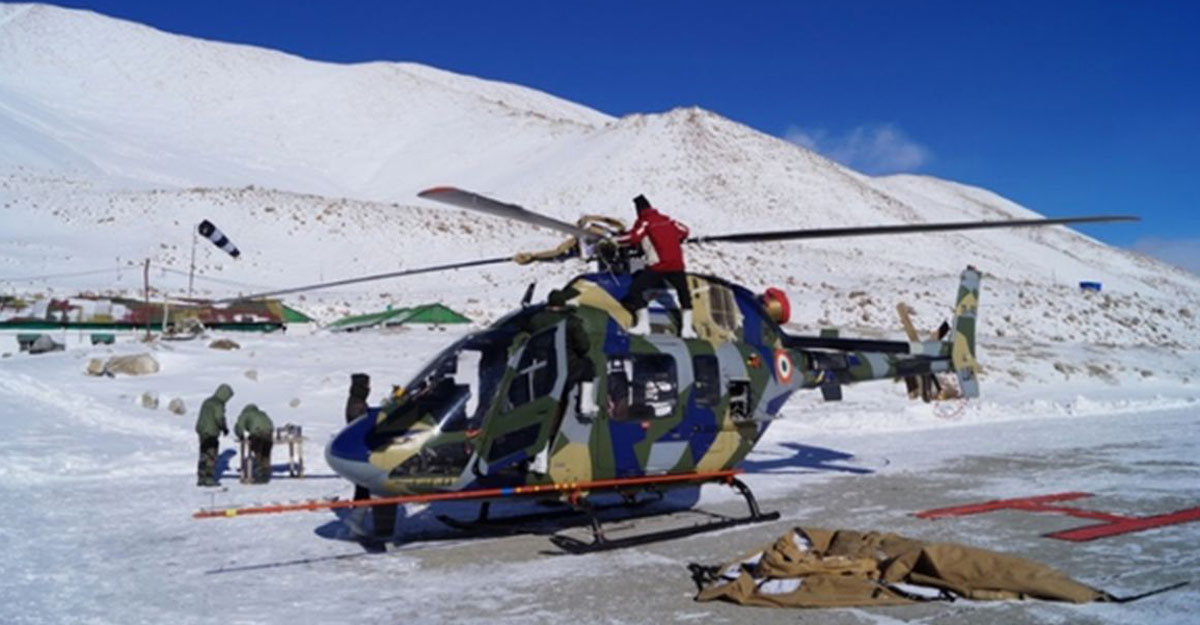
SOURCE: Anantha Krishnan M / MANORAMA ONLINE
The Light Utility Helicopter (LUH), the latest rotor platform to fly out of the hangars of Hindustan Aeronautics Limited (HAL), has hit the headlines with its stunning performance during the recent trials at Himalayas.
In this report, Onmanorama takes a look at the LUH story so far, the technologies involved and the unique features of this desi flying machine. The need for LUH was felt after the Indian Army and the Indian Air Force sought a platform in the three-tonne class to carry out missions at the high altitudes of Himalayan and Glacier regions, given their strategic importance.
Currently, the ageing fleets of Cheetahs and Chetak helicopters operate at these high altitudes facing several limitations and obsolescence issues.
“The Advanced Light Helicopter (ALH) too can operate at high altitudes but may not be from bases with smaller helipads. This necessitated the IAF and the Indian Army to jointly issue the Staff Requirements for LUH with the state-of-the-art technologies to perform at high altitudes with considerable payloads,” said an official, who spoke to Onmanorama.
A total of 384 Reconnaissance and Surveillance Helicopters (RSH) were projected by the Services in which 197 were in ‘Buy’ category and 187 in the ‘Make’ category.
The LUH is a design and development project, sanctioned by the Cabinet Committee on Security in 2009. It is undertaken by HAL as a fully indigenous development project.
Powered by a single turbo shaft engine Ardiden 1U from Safran Helicopter Engine (France), the LUH is designed for roles such as reconnaissance, surveillance, troop transportation, aerial photography and casualty evacuation.
The maiden flight of the first prototype (PT-1) was carried out on September 6, 2016; the second prototype (PT-2) flew on May 22, 2017 and the third one (PT-3) took to the skies on December 14, 2018.
Trials Completed
All certification activities like ground testing, ground test vehicle endurance runs, system testing, hot weather trials, cold weather trials, sea level trials and hot weather high altitude trials have been completed.
“Further, the user evaluation of hot and high altitude trials was carried out and the helicopter demonstrated its payload capability in Siachen glacier during August and September this year,” the official said.
Presently, three prototypes have completed about 600 hours of flight testing since 2016.
“In addition to meeting the requirements of armed forces, the LUH is designed to provide excellent performance at high altitude operations and with growth potential to accommodate additional equipment in future based on emerging needs. These features make LUH stand out in comparison to other contemporary helicopters in its class,” he added.
The Initial Operational Clearance (IOC) for the basic LUH for IAF was accorded by the Centre for Military Airworthiness and Certification in during the DefExpo held in Lucknow in February.
HAL is expecting the IOC for basic LUH version for the Indian Army shortly.
“Series production of LUH is being proposed to launch shortly. As a part of concurrent planning, we have acquired 610 acres of land at Tumkur for establishing a dedicated manufacturing facility for LUH. We plan to produce minimum 30 to 40 helicopters per year at the beginning stage itself which can be improved further,” said the official.
Desi Systems
Critical systems like, rotor and transmission are indigenously designed and development by the Rotary Wing Research & Design Centre of HAL.
“Further, other divisions of HAL have developed avionics and electrical systems for LUH. From the beginning, we have partnered with many MSMEs and private industries in realization of machining components, cockpit display system and several stand-by instruments,” he said.
Some of the private industries that participated in the LUH programme include: Data Patterns, Datasol, Southern Electronics, Prudent Communications and Shanti Gears.
“With this, we have achieved maximum content of indigenization about in 65 per cent in the LUH programme. With the IP rights of the helicopter owned by HAL, any future adaptations can be undertaken within India to match with emerging operational requirements of our armed forces,” the official said.
Several new concepts like two segment main rotor blade, Smart Cockpit Display System, Health & Usage Monitoring System (HUMS) and Passive Vibration Isolation System (PVIS) have been incorporated in the helicopter.
Key Features
Predominantly composite airframe with excellent crashworthy features.
•Main and tail rotor blades made out of composite material for damage tolerance capability. The hinge-less rotor system ensures high agility and maneuverability of the helicopter.
•Spacious cabin ensuring enough room for troop transport up to six troops or two stretchers with a medical attendant or large volume internal cargo.
•The gen-next avionics suite with fully integrated Multi-Functional Displays and indigenously developed application software.
•Modern engine with high indigenous content, manufacturing and repair and overhaul (RoH) rights with HAL.
•Several dual redundant systems ensuring higher levels of safety.
•Single engine with dual channel automatic fuel control (FADEC) with additional backup control.
•Night flying capability and crashworthy features.
“We have integrated state-of-the art technologies and systems in LUH. It can cater to the emerging needs in this class of helicopter for the next three to four decades. Design concepts adopted in the LUH make it a versatile platform,” the official added.






